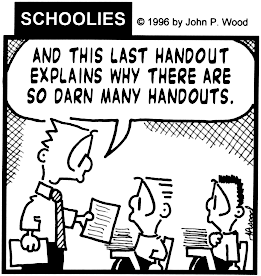Why I don’t make copies of my slides available
September 13, 2010 Filed under Blog, Featured, News, Potpourri, Presentations

As I describe in the Preface to Eloquent Science, the book arose out of a workshop that I taught to undergraduates in Oklahoma. The workshop arose over six years, with what were essentially my lecture notes on PowerPoint slides. The slides were wordy and boring. During the talk, the students had paper copies of my presentation in front of them so that they could take notes and not feel compelled to write down everything from the slides. I knew this was inadequate. I knew that this was not the example of a compelling workshop presentation that I knew that I could give and was best for the students. Yet, I continued to teach the workshop this way. When I decided to write the book, a big weight was lifted because I could give more appropriate and interesting presentations, but then refer the students to the material in the book, which had the full explanation of what I wanted to say.
One of the questions that I sometimes receive is whether I would make a PDF or PowerPoint copy of my presentations available before or after the workshop. As Garr Reynolds argues in Presentation Zen: Simple Ideas on Presentation Design and Delivery, giving the audience printouts of your presentation undermines your ability to command their attention during the presentation and to present the material at the pace you want. Imagine that you were handed a stack of papers of what the speaker was going to say before a seminar started. In the few minutes before the presentation started—or worse yet, during the presentation—you would be sifting through the handout looking for interesting material and the presenter’s main points. You wouldn’t be paying attention to the speaker. Also, if there were humor or surprises on the slides, the impact would be much less if you were already aware of them beforehand.
Think back on the last set of handouts from a talk that you received. Usually you get three slides per page with a column of lines for taking notes. Have you really filled the space allotted with notes? If you’re lucky, the pages were double-sided, saving money, trees, and space in your files, but often they are not. After the presentation is over, how many times have you gone back and referred to that presentation? My guess is that it is zero nearly every single time.
If handouts are required (and there are often good reasons for doing so), Garr Reynolds argues that you should provide a one- or two-page summary of your main points and any essential figures. The audience will have your presentation boiled down to its essence by the speaker; you will have saved trees, money and space; and the audience will focus on you rather than the handouts.
As Chuck Doswell is fond of saying, if you and I both agree, then one of us is irrelevant. Sets of handouts imply that there is value in the content of the slides apart from the speaker. My slides are often designed to be backdrops for which I can tell stories. If you only had my slides, you would miss much of what I am conveying.
The last thing to know is that your slides are your intellectual property. Although your scientific articles will only be published once for your audience to read anytime they want, the value in a presentation is that it can be given multiple times to different audiences, and your seminar or conference presentation becomes an event to attend. In the case of slides from my workshop, much of the material is in Eloquent Science anyway. What isn’t are the anecdotes, which you don’t get from the slides. If you have my book, then you have the material that is in the slides.
So, for all of these reasons, I advocate not making your presentations available through files or on paper to the audience. I know that this advice goes against what you see happen in many meetings, but I honestly think that if we stop and think about what we are doing and why, we will see that there are better ways. Is a handout really necessary? If so, then provide a short one- or two-page summary, as I have suggested above.


